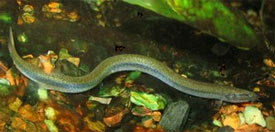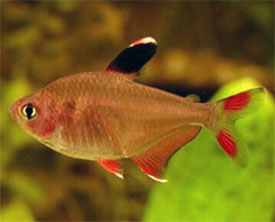
 Magyarul / Hungarian
Magyarul / Hungarian
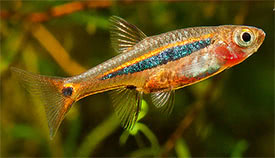
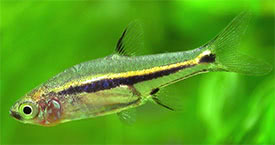
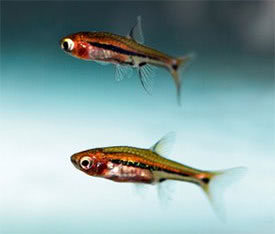

- Scientific name: Boraras urophthalmoides
- Synonyms: Rasbora urophthalmoides
- Common name: Least Rasbora, Exclamation Point Rasbora
- Group: Cyprinids
- Habitat: Asia; Thailand, Vietnam, Cambodia
- Size: 1-1,6 cm
- Biotope: Found in shallow waters, like swamps or rice paddies, where the water is mostly clear with dense aquatic vegetation. They often move into flooded areas during the wet season.
- Social behavior: A very peaceful shoaling fish, but not ideal for community tanks because of its small size. In larger groups (8-10 fish) they become bolder, and males will also display their best colors as they compete with each other.
- Diet: Omnivorous; in nature they eat small invertebrates and their larvae. In the aquarium they accept everything: live, frozen and flake foods too.
- Breeding: Quite easy
- Tank: Minimum 30 litres
- Population: 8-10 fish for 40 litres
- Decoration: They deserve a heavily-planted tank with some roots or branches. Use some floating plants to dim the lighting. Water movement shouldn’t be too strong.
- Temperature: 24-28 °C
- pH: 6-7
- Hardness: 1-10 NK°
- Lifespan: 4 years
Description: Boraras urophthalmoides has brownish orange body with a horizontal dark stripe on the flank, and smaller dark spots at base of anal and caudal fin. The Least Rasbora has also been nicknamed the Exclamation Point Rasbora because of this color pattern. Over the dark stripe there is a bright orange, or yellow band. Least Rasbora’s color may depend on collection locality, which can cause some confusion with Boraras brigittae as some populations can develop a strong orange or red stripe above the dark lateral line. Boraras urophthalmoides can be easily identified by its smaller adult size, distinct round, dark blotch on the caudal peduncle, longer lateral line and less uniformly red patterning. Mature females are a little larger and plumper, than the more colourful males.
Like many small cyprinids, the Least Rasbora is an egg-scatterer spawner, with no parental care. Well-fed fish will usually spawn, and it is possible that a small numbers of fry survive in the community tank. They can be bred in a small (12-15 litres), dimly lighted tank, that filled with Java moss. Water should be very soft (1-5 NK°), of slightly acidic (5-6,5). Two or three pairs of well-conditioned mature fish should be introduced to the breeding-tank, where they should begin to spawn the following morning. The adult fish should be removed after a few days, as the eggs should hatch by the second day after the spawning, and the adults will eat the fry. After 24 hours the small fry can be fed with microfoods. After another week they are usually large enough to eat brine shrimp nauplii. It is best to wait one or two weeks before starting to perform small water changes in order to avoid shocking the young fish.





















































